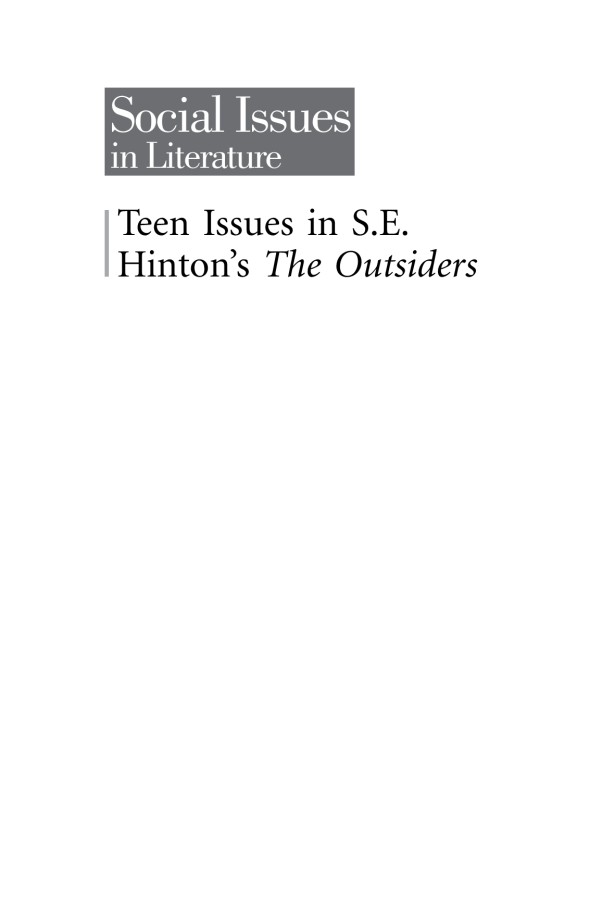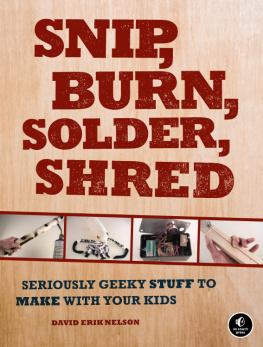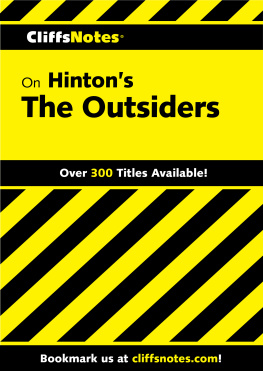

Other Books in the Social Issues in Literature Series:
Class Conflict in Emily Bronts Wuthering Heights
Colonialism in Joseph Conrads Heart of Darkness
Depression in Sylvia Plaths The Bell Jar
The Environment in Rachel Carsons Silent Spring
Genocide in Ann Franks The Diary of a Young Girl
Poverty in John Steinbecks The Pearl
Race in Ralph Ellisons Invisible Man
Race in William Shakespeares Othello
War in Kurt Vonneguts Slaughterhouse-Five
Womens Issues in Kate Chopins The Awakening
Womens Issues in Margaret Atwoods The Handmaids Tale
Womens Issues in Zora Neale Hurstons
Their Eyes Were Watching God
Womens Search for Independence in Charlotte Brontes Jane Eyre

Elizabeth Des Chenes, Director, Publishing Solutions
2012 Greenhaven Press, a part of Gale, Cengage Learning
Gale and Greenhaven Press are registered trademarks used herein under license.
For more information, contact:
Greenhaven Press
27500 Drake Rd.
Farmington Hills, MI 48331-3535
Or you can visit our Internet site at gale.cengage.com
ALL RIGHTS RESERVED.
No part of this work covered by the copyright herein may be reproduced, transmitted, stored, or used in any form or by any means graphic, electronic, or mechanical, including but not limited to photocopying, recording, scanning, digitizing, taping, Web distribution, information networks, or information storage and retrieval systems, except as permitted under Section 107 or 108 of the 1976 United States Copyright Act, without the prior written permission of the publisher.
For product information and technology assistance, contact us at
Gale Customer Support, 1-800-877-4253
For permission to use material from this text or product, submit all requests online at www.cengage.com/permissions
Further permissions questions can be emailed to
Articles in Greenhaven Press anthologies are often edited for length to meet page requirements. In addition, original titles of these works are changed to clearly present the main thesis and to explicitly indicate the authors opinion. Every effort is made to ensure that Greenhaven Press accurately reflects the original intent of the authors. Every effort has been made to trace the owners of copyrighted material.
Cover image freelanceartist/Shutterstock.com.
LIBRARY OF CONGRESS CATALOGING-IN-PUBLICATION DATA
Teen issues in S.E. Hintons The outsiders / David E. Nelson, book editor.
p. cm. -- (Social issues in literature)
Includes bibliographical references and index.
ISBN 978-0-7377-5809-2 (hardcover) -- ISBN 978-0-7377-5810-8 (pbk.)
1. Hinton, S. E. Outsiders. 2. Teenagers in literature. I. Nelson, David E.
PS3558.I548O989 2012
813.54--dc23
2012006898
Printed in the United States of America
1 2 3 4 5 6 7 16 15 14 13 12
Contents
J. Sydney Jones
An overview of S.E. Hintons life and writing as understood through Hintons novels and childrens books.
S.E. Hinton, as told to Lisa Ehrichs
In this 1981 interview, Hinton discusses her growing fame, why she wrote The Outsiders and other gritty young adult novels, and her advice to young writers.
S.E. Hinton and Anne Commire
Selections from several different interviews with Hinton detail the authors experience working with Hollywood directors, screenwriters, and actors on the film adaptations of several of her novels.
Connie Ogle
The popularity of Hintons best-known work, The Outsiders, continues, even as her writing has evolved to encompass a variety of genres.
Stephanie Zacharek
Hintons writing for adults, although often lean and well crafted, cannot match her young adult work, including The Outsiders. Her young adult novels draw their energy from their honest depiction of the taboos that define teen life.
Michael Malone
Despite being heralded for its gritty realism, The Outsiders is not very realistic at all but rather a kind of hybrid fairy-tale romance novel. The book attracts teens not because of its supposed realism but because it speaks directly and persuasively to their idealism.
Michael Pearlman
The authors of adolescent fictionincluding Hinton employ socioeconomic status within their novels both to define their characters and to show how characters change over the course of the novel. This invites readers to at once see the reality of socioeconomic class and look past it.
Eric L. Tribunella
At first glance The Outsiders appears to attack the unfair distribution of wealth and power in America by highlighting the injustice of the arbitrary divisions between the rich and poor. But the book ultimately undercuts its own message and reinforces the existing system.
June Pulliam
The Outsiders offers an interesting and nuanced analysis of class and gender. While wealth and social class seem to liberate the Socs, Hinton also seems to argue that class condemns them to rigid gender roles. Meanwhile, by virtue of their tough image, greasers are able to engage in what would otherwise be unacceptably feminine behavior.
Ellen A. Seay
This viewpoint compares Hintons The Outsiders with Bret Easton Elliss Less than Zero, a novel steeped in violence, profanity, and morally ambiguous sex. Despite many differences in both aesthetics and plot, both novels depict worlds devoid of nurturing adults.
Lizzie Skurnick
Hintons novels demonstrate that the brotherhood offered by gangsas opposed to the nuclear family and its extended networkis the primary social support network available to many boys living in poverty.
Michael Modleski
The Outsiders continues to be a popular book among educators both for its clear language and plotting and its positive social messages. Certain classroom methods can maximize the books impact among middle school readers.
Nordette Adams
In July 2008 Nebraska enacted a safe-haven law that, due to its wording, made it possible for a parent to legally abandon his or her children at any Nebraska hospital. During the few months this law was in effect, thirty-five children (many of them troubled teens from out of state) were dumped at Nebraska hospitals, their parents driven by financial crisis or other desperate circumstances.
Lori Gottlieb
Wealthy parents obsessed with their childrens happiness and self-esteem may inadvertently raise a generation of adults mired in indecisiveness, anxiety, and depression eerily familiar to the Socs description of the home life of Bob Sheldon, the Soc that Johnny kills in self-defense.
Jane Velez-Mitchell
The epidemic of teen violence can be traced to three factors: (1) the glorification of violent problem solving, (2) a criminal justice system that behaves brutally toward wayward youths, and (3) a lack of steadfast parenting and adult mentoring for boys.
Jessica Portner
Suicide has sharply increased in the United States since the 1960s. Today, one out of every thirteen teens attempts suicide. Such self-destructive behavior takes many forms, including, for some teens desperately seeking escape from gang life, suicide by cop.
Next page















